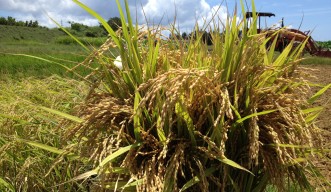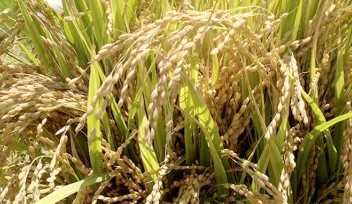Combating Obesity with New Okinawan Rice

In recent years, Okinawa has recorded the dubious distinction of having the highest obesity rate in Japan. Preventing obesity-related diseases is an urgent issue. Professor Hidetoshi Saze of the OIST Plant Epigenetics Unit is leading a new research project to develop a new strain of rice that produces digestion-resistant starch to prevent these diseases. The project, fostered by the Okinawan government, involves three activities by the medical, agricultural, and food industries: development of the new rice strain, nutritional and physiological analyses, and processing and sales.
Nanshoka-Mai, or rice with digestion-resistant starch is a new breed of rice rich in starch that does not as readily break down into glucose. This rice strain was first developed by a research team at Kyushu University 30 years ago. The starch from most grains, which consist largely of an unbranched glucose polymer known as amylose, is normally broken down into glucose during the digestive process and serves as our primary energy source. However, excessive consumption of sugars (simple carbohydrates) can cause life-style-related diseases, such as obesity and diabetes. This new strain of rice is expected to serve as an alternative preventative measure. In addition to its anti-obesity effect, gathering evidence suggests that the rice with digestion-resistant starch may also provide other benefits, such as lower blood sugar levels, reduced neutral fat, and harmful cholesterol levels, and prevention of lipid accumulation in the liver.
Despite its great promise, when researchers planted the original strain of resistant-starch rice in Okinawa, the yield per hectare was about half that achieved in mainland Japan. Prof. Saze and his team then started hybridizing the resistant-starch rice with local strains to genetically design a new strain of rice suited to Okinawa’s climate. Using OIST’s next-generation sequencing machines, Prof. Saze is analyzing genomes of these rice strains. He is also using plant incubators in his unit to shorten the vegetation period of the new rice. It is important to obtain the support of rice producers in Okinawa by demonstrating a clear economic, as well as health benefits of the resistant-starch rice. “The resistant-starch rice can be used in many food products. I hope that our project will improve people’s health,” said Prof. Saze.
In order to assess the effects of the resistant-starch rice, the project also involves medical and physiological studies by the University of the Ryukyus, Osaka Prefectural University, and Ishikawa Prefectural University. Moreover, some local companies are working together to develop processed foods with rice powder produced from the resistant-starch rice. Whether they are staples or regional specialities, in the near future, we may be able to see many more healthy local products on store shelves.
By Mayumi Nishioka
Specialties
Research Unit
For press enquiries:
Press Inquiry Form

















